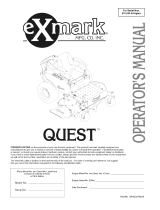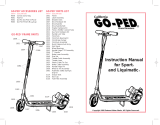
Controls ............................................................. 12
Operation ................................................................... 13
Think Safety First ............................................... 13
Recommended Gasoline ..................................... 13
Chec_ng the Engine Oil Level ............................ 15
Starting the Engine ............................................. 15
Operating the Blades .......................................... 16
Stopping the Engine ........................................... 17
The Safety Interlock System ................................ 17
Driving Forward or Backward ............................. 18
Stopping the Machine ......................................... 18
Adjusting the Height of Cut ................................ 18
Positioning the Seat ............................................ 19
Adjusting the Motion Control Levers .................. 19
Pushing the Machine by Hand ............................. 19
Side Discharge .................................................... 20
Operating Tips ................................................... 20
Maintenance ............................................................... 22
Recommended Maintenance Schedule(s) ................ 22
Premaintenance Procedures .................................... 23
Raising the Seat .................................................. 23
Accessing the Battery ......................................... 23
Lubrication ............................................................. 23
Greasing the Bearings ......................................... 23
Engine Maintenance ............................................... 24
Servicing the Air Cleaner .................................... 24
Servicing the Engine Oil ..................................... 25
Servicing the Spark Plug ..................................... 27
Cleaning the Blower Housing .............................. 27
Fuel System Maintenance ....................................... 28
Replacing the Fuel Filter ..................................... 28
Electrical System Maintenance ................................ 29
Charging the Battery ........................................... 29
Servicing the Fuses ............................................. 30
Drive System Maintenance ..................................... 31
Chec_ng the Tire Pressure ................................. 31
Mower Maintenance ............................................... 32
Servicing the Cutting Blades ............................... 32
Leveling the Mower from Side-to-Side ................ 33
Adjusting the Front-to-Rear Blade Slope ............. 34
Removing the Mower ......................................... 35
Mower Belt Maintenance .................................... 36
Installing the Mower ........................................... 36
Replacing the Grass Deflector ............................. 37
Cleaning ................................................................. 38
Washing the Underside of the Mower .................. 38
Storage ....................................................................... 39
Cleaning and Storage .......................................... 39
Troubleshooting ......................................................... 40
Schematics ................................................................. 42
Safety
This machine meets or exceeds the B71.1-2003
specifications of the American National Standards
Institute, in effect at the time of production.
However, improper use or maintenance by the
operator or owner can result in injury. To reduce
the potential for injury, comply with these safety
instructions and always pay attention to the
safety alert symbol, which means CAUTION,
WARNING, or DANGER-"personal safety
instruction." Failure to comply with the instruction
may result in personal injury or death.
Safe Operating Practices
The following instructions are from ANSI standard
B71.1-2003.
This product is capable of amputating hands and
feet and throwing objects. Always follow all safety
instructions to avoid serious injury or death.
General Operation
• Read, understand, and follow all instructions in
the operator's manual and on the machine before
starting.
• Do not place hands or feet near rotating parts or
under the machine. Keep clear of the discharge
opening at all times.
• Allow only responsible adults who are familiar with
the instructions to operate the machine.
• Clear the area of objects such as rocks, toys, wire,
etc., which could be picked up and thrown by the
blade.
• Be sure the area is clear of other people before
mowing. Stop the machine if awone enters the area.
• Never carry passengers.
• Do not mow in reverse unless absolutely necessar 7
Akvays look down and behind before and while
bac_ng up.
• Be aware of the mower discharge direction and do
not point it at awone. Avoid discharging material
against a wall or obstruction. Material may ricochet
back toward the operator. Stop the blade(s) when
crossing gravel surfaces.
• Do not operate the machine without deflector,
discharge cover or entire grass collection system in
place and wor_ng.
• Be alert, slow down and use caution when ma_ng
turns. Look behind and to the side before changing
directions.
























